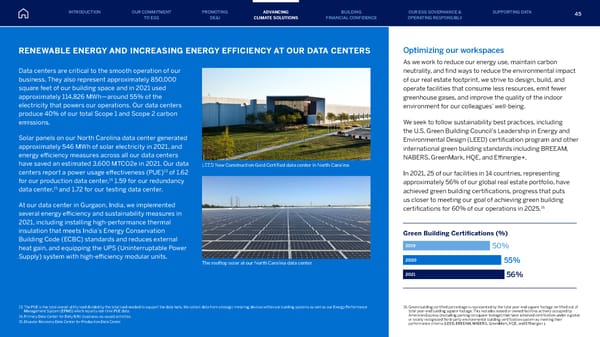Data centers are critical to the smooth operation of our business. They also represent approximately 850,000 square feet of our building space and in 2021 used approximately 114,826 MWh—around 55% of the electricity that powers our operations. Our data centers produce 40% of our total Scope 1 and Scope 2 carbon emissions. Solar panels on our North Carolina data center generated approximately 546 MWh of solar electricity in 2021, and energy efficiency measures across all our data centers have saved an estimated 3,600 MTCO2e in 2021. Our data centers report a power usage effectiveness (PUE) 13 of 1.62 for our production data center, 14 1.59 for our redundancy data center, 15 and 1.72 for our testing data center. At our data center in Gurgaon, India, we implemented several energy efficiency and sustainability measures in 2021, including installing high-performance thermal insulation that meets India’s Energy Conservation Building Code (ECBC) standards and reduces external heat gain, and equipping the UPS (Uninterruptable Power Supply) system with high-efficiency modular units. RENEWABLE ENERGY AND INCREASING ENERGY EFFICIENCY AT OUR DATA CENTERS 13. The PUE is the total overall utility load divided by the total load needed to support the data halls. We collect data from strategic metering devices within our building systems as well as our Energy Performance Management System (EPMS) which reports real-time PUE data. 14. Primary Data Center for Daily BAU (business-as-usual) activities 15. Disaster Recovery Data Center for Production Data Center Optimizing our workspaces As we work to reduce our energy use, maintain carbon neutrality, and find ways to reduce the environmental impact of our real estate footprint, we strive to design, build, and operate facilities that consume less resources, emit fewer greenhouse gases, and improve the quality of the indoor environment for our colleagues’ well-being. We seek to follow sustainability best practices, including the U.S. Green Building Council’s Leadership in Energy and Environmental Design (LEED) certification program and other international green building standards including BREEAM, NABERS, GreenMark, HQE, and Effinergie+. In 2021, 25 of our facilities in 14 countries, representing approximately 56% of our global real estate portfolio, have achieved green building certifications, progress that puts us closer to meeting our goal of achieving green building certifications for 60% of our operations in 2025. 16 Green Building Certifications (%) 50% 55% 56% 2021 2020 2019 The rooftop solar at our North Carolina data center LEED New Construction Gold Certified data center in North Carolina 16. Green building certified percentage is represented by the total year-end square footage certified out of total year-end building square footage. This includes leased or owned facilities actively occupied by American Express (excluding parking lot square footage) that have achieved certification under a global or locally recognized third-party environmental building certification system as meeting their performance criteria (LEED, BREEAM, NABERS, GreenMark, HQE, and Effinergie+). INTRODUCTION PROMOTING DE&I ADVANCING CLIMATE SOLUTIONS BUILDING FINANCIAL CONFIDENCE OUR ESG GOVERNANCE & OPERATING RESPONSIBLY SUPPORTING DATA OUR COMMITMENT TO ESG 45
 American Express ESG Report Page 44 Page 46
American Express ESG Report Page 44 Page 46